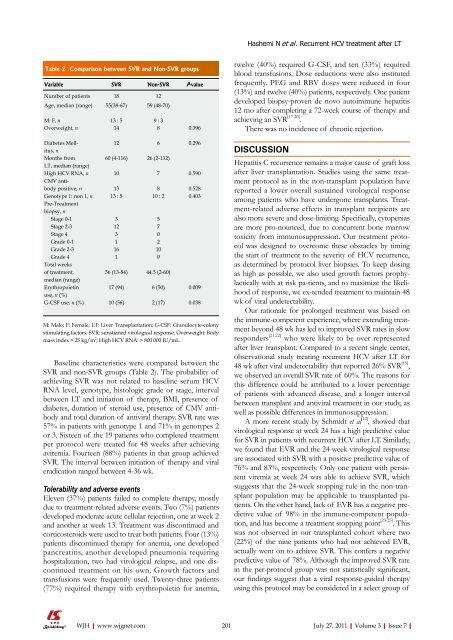7 - World Journal of Gastroenterology
7 - World Journal of Gastroenterology
7 - World Journal of Gastroenterology
- No tags were found...
You also want an ePaper? Increase the reach of your titles
YUMPU automatically turns print PDFs into web optimized ePapers that Google loves.
Hashemi N et al . Recurrent HCV treatment after LTTable 2 Comparison between SVR and Non-SVR groupsVariable SVR Non-SVR P-valueNumber <strong>of</strong> patients 18 12Age, median (range) 55(38-67) 59 (48-70)M: F, n 13 : 5 9 : 3Overweight, n 14 8 0.396Diabetes Mellitus,nMonths fromLT, median (range)High HCV RNA, nCMV antibodypositive, nGenotype 1: non 1, nPre-Treatmentbiopsy, nStage 0-1Stage 2-3Stage 4Grade 0-1Grade 2-3Grade 4Total weeks<strong>of</strong> treatment,median (range)Erythropoietinuse, n (%)G-CSF use, n (%)12 6 0.29660 (4-116)101313 : 53123116156 (13-84)17 (94)10 (56)26 (2-132)Baseline characteristics were compared between theSVR and non-SVR groups (Table 2). The probability <strong>of</strong>achieving SVR was not related to baseline serum HCVRNA level, genotype, histologic grade or stage, intervalbetween LT and initiation <strong>of</strong> therapy, BMI, presence <strong>of</strong>diabetes, duration <strong>of</strong> steroid use, presence <strong>of</strong> CMV antibodyand total duration <strong>of</strong> antiviral therapy. SVR rate was57% in patients with genotype 1 and 71% in genotypes 2or 3. Sixteen <strong>of</strong> the 19 patients who completed treatmentper protocol were treated for 48 weeks after achievingaviremia. Fourteen (88%) patients in that group achievedSVR. The interval between initiation <strong>of</strong> therapy and viraleradication ranged between 4-36 wk.Tolerability and adverse eventsEleven (37%) patients failed to complete therapy, mostlydue to treatment-related adverse events. Two (7%) patientsdeveloped moderate acute cellular rejection, one at week 2and another at week 13. Treatment was discontinued andcorticosteroids were used to treat both patients. Four (13%)patients discontinued therapy for anemia, one developedpancreatitis, another developed pneumonia requiringhospitalization, two had virological relapse, and one discontinuedtreatment on his own. Growth factors andtransfusions were frequently used. Twenty-three patients(77%) required therapy with erythropoietin for anemia,7810 : 2570210044.5 (2-60)6 (50)2 (17)0.5900.5280.4030.0090.038M: Male; F: Female; LT: Liver Transplantation; G-CSF: Granulocyte-colonystimulating factors; SVR: sunstianed virological response. Overweight: Bodymass index > 25 kg/m 2 ; High HCV RNA: > 800 000 IU/mL.twelve (40%) required G-CSF, and ten (33%) requiredblood transfusions. Dose reductions were also institutedfrequently. PEG and RBV doses were reduced in four(13%) and twelve (40%) patients, respectively. One patientdeveloped biopsy-proven de novo autoimmune hepatitis12 mo after completing a 72-week course <strong>of</strong> therapy andachieving an SVR [17-20] .There was no incidence <strong>of</strong> chronic rejection.DISCUSSIONHepatitis C recurrence remains a major cause <strong>of</strong> graft lossafter liver transplantation. Studies using the same treatmentprotocol as in the non-transplant population havereported a lower overall sustained virological responseamong patients who have undergone transplants. Treatment-relatedadverse effects in transplant recipients arealso more severe and dose-limiting. Specifically, cytopeniasare more pro-nounced, due to concurrent bone marrowtoxicity from immunosuppression. Our treatment protocolwas designed to overcome these obstacles by timingthe start <strong>of</strong> treatment to the severity <strong>of</strong> HCV recurrence,as determined by protocol liver biopsies. To keep dosingas high as possible, we also used growth factors prophylacticallywith at risk pa-tients, and to maximize the likelihood<strong>of</strong> response, we ex-tended treatment to maintain 48wk <strong>of</strong> viral undetectability.Our rationale for prolonged treatment was based onthe immune-competent experience, where extending treatmentbeyond 48 wk has led to improved SVR rates in slowresponders [21,22] who were likely to be over representedafter liver transplant. Compared to a recent single center,observational study treating recurrent HCV after LT for48 wk after viral undetectability that reported 26% SVR [15] ,we observed an overall SVR rate <strong>of</strong> 60%. The reasons forthis difference could be attributed to a lower percentage<strong>of</strong> patients with advanced disease, and a longer intervalbetween transplant and antiviral treatment in our study, aswell as possible differences in immunosuppression.A more recent study by Schmidt et al [12] , showed thatvirological response at week 24 has a high predictive valuefor SVR in patients with recurrent HCV after LT. Similarly,we found that EVR and the 24-week virological responseare associated with SVR with a positive predictive value <strong>of</strong>76% and 83%, respectively. Only one patient with persistentviremia at week 24 was able to achieve SVR, whichsuggests that the 24-week stopping rule in the non-transplantpopulation may be applicable to transplanted patients.On the other hand, lack <strong>of</strong> EVR has a negative predictivevalue <strong>of</strong> 98% in the immune-competent population,and has become a treatment stopping point [23-25] . Thiswas not observed in our transplanted cohort where two(22%) <strong>of</strong> the nine patients who had not achieved EVR,actually went on to achieve SVR. This confers a negativepredictive value <strong>of</strong> 78%. Although the improved SVR ratein the per-protocol group was not statistically significant,our findings suggest that a viral response-guided therapyusing this protocol may be considered in a select group <strong>of</strong>WJH|www.wjgnet.com 201July 27, 2011|Volume 3|Issue 7|

















